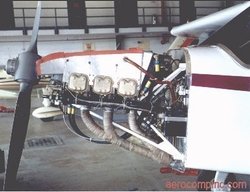Wed, Jan 08, 2003
Increased Quality and Testing Systems Implemented
 Lycoming has received final certification from the FAA for the
production of new crankshafts. Already in limited production on a
risk-release basis (allowing production to begin prior to
certification), these crankshafts will be used to replace
crankshafts in Lycoming engines affected by Service Bulletins 550,
552 and 553.
Lycoming has received final certification from the FAA for the
production of new crankshafts. Already in limited production on a
risk-release basis (allowing production to begin prior to
certification), these crankshafts will be used to replace
crankshafts in Lycoming engines affected by Service Bulletins 550,
552 and 553.
Each crank will be inspected by SEM.
Working closely with the FAA, Lycoming and its supplier have
improved the production, quality and testing processes for the
crankshafts. Additional improvements to these processes
include:
- Press forging of all crankshafts with automated induction
heating
- Temperature monitoring at furnace exit when forging
crankshafts
- Enhanced work instructions for supplier shop floor
personnel
- Comprehensive training of supplier personnel
- Impact (Charpy) testing on all replacement crankshafts
- Scanning Electron Microscope analysis of each crankshaft
- Increased frequency of quality audits at the supplier by
Lycoming personnel
 "We are confident that the new production process
is sound and that stringent systems are in place to protect against
a repeat of the problem. However, as safety is our top priority, we
continue to conduct testing of each and every crankshaft to be
certain the process is working correctly," said Lycoming President
Mike Wolf. To date, more than 600 replacement crankshaft forgings
have been successfully produced and tested.
"We are confident that the new production process
is sound and that stringent systems are in place to protect against
a repeat of the problem. However, as safety is our top priority, we
continue to conduct testing of each and every crankshaft to be
certain the process is working correctly," said Lycoming President
Mike Wolf. To date, more than 600 replacement crankshaft forgings
have been successfully produced and tested.
"Beginning today, about 15 Lycoming Authorized Repair Facilities
around the world, including Lycoming's factory and service center,
will install replacement crankshafts in 20-30 engines a day as
production crankshafts become available," the company said Tuesday.
Lycoming's factory will have an assembly line and staging area
dedicated to both engine inspection and parts flow coordination.
Once off the line, each engine will be thoroughly tested.
Lycoming's goal is to install replacement crankshafts in all the
affected engines by early in the second quarter of 2003.
Unprecedented customer care, in the meantime...
Until the affected engines are returned to service, Lycoming has
offered one of the most extensive Customer Care programs in general
aviation history to help alleviate customer inconvenience. In
addition to repairing and replacing internal parts, the program
includes alternate transportation or fixed costs (includes interest
on loans, ground insurance and hangar rental), and remote hangar
fees, plus an additional 12 month engine warranty from the date the
engine is returned to service. Lycoming has earmarked over $35
million to fund these efforts.
More News
From 2023 (YouTube Version): Legacy of a Titan Robert (Bob) Anderson Hoover was a fighter pilot, test pilot, flight instructor, and air show superstar. More so, Bob Hoover was an i>[...]
Get The Latest in Aviation News NOW on Instagram Are you on Instagram yet? It's been around for a few years, quietly picking up traction mostly thanks to everybody's new obsession >[...]
Aero Linx: B-52H Stratofortress The B-52H Stratofortress is a long-range, heavy bomber that can perform a variety of missions. The bomber is capable of flying at high subsonic spee>[...]
Altimeter Setting The barometric pressure reading used to adjust a pressure altimeter for variations in existing atmospheric pressure or to the standard altimeter setting (29.92).>[...]
"Knowing that we play an active part in bettering people's lives is extremely rewarding. My team and I are very thankful for the opportunity to be here and to help in any way we ca>[...]
 Classic Aero-TV: Remembering Bob Hoover
Classic Aero-TV: Remembering Bob Hoover ANN FAQ: Follow Us On Instagram!
ANN FAQ: Follow Us On Instagram! ANN's Daily Aero-Linx (05.15.24)
ANN's Daily Aero-Linx (05.15.24) ANN's Daily Aero-Term (05.15.24):Altimeter Setting
ANN's Daily Aero-Term (05.15.24):Altimeter Setting Aero-News: Quote of the Day (05.16.24)
Aero-News: Quote of the Day (05.16.24)




